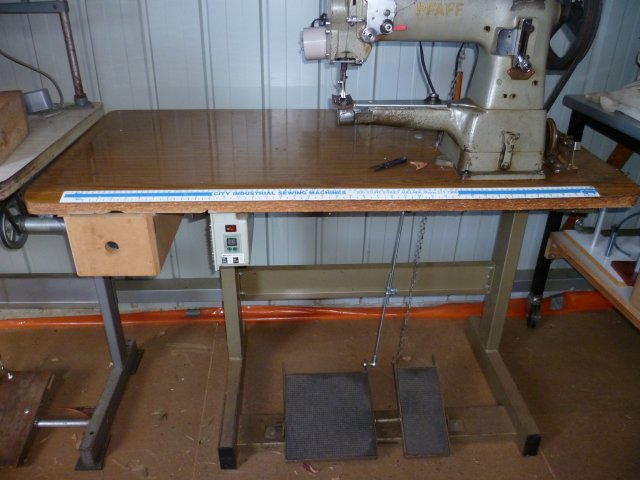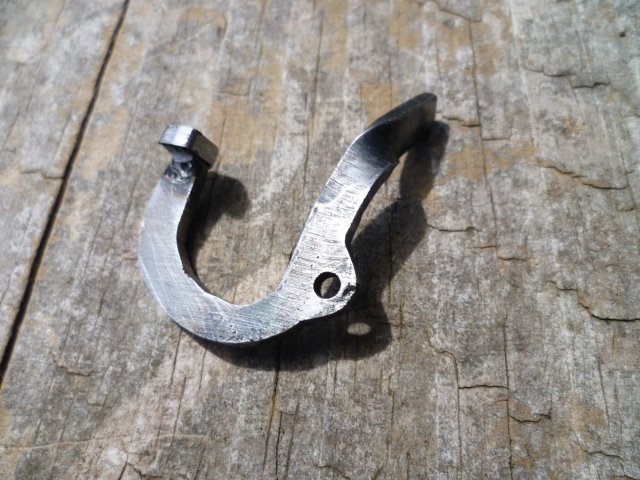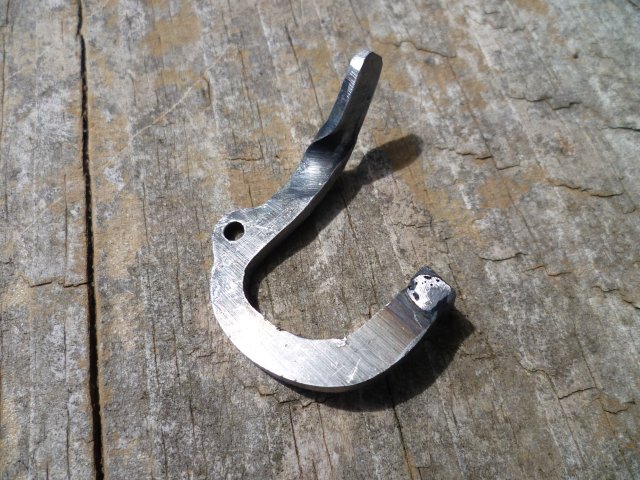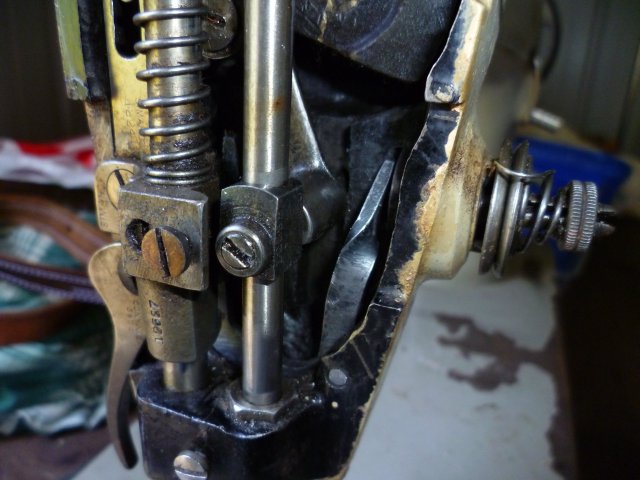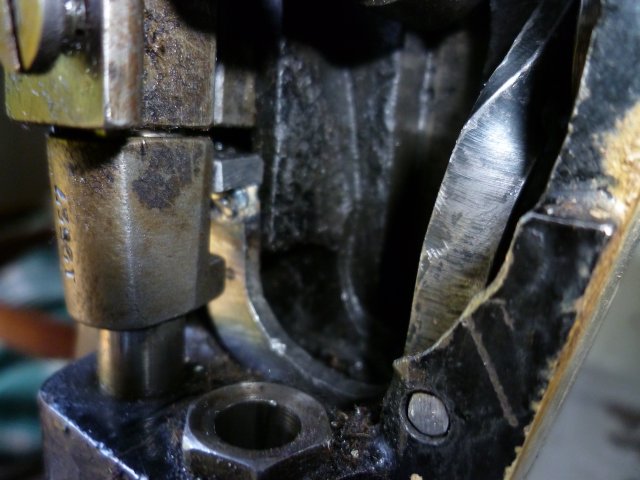-
Posts
4,784 -
Joined
-
Last visited
Content Type
Profiles
Forums
Events
Blogs
Gallery
Everything posted by dikman
-
Mike, thanks for a most interesting discourse. While I'm in no way in your league (some would say I'm one level above bodgery!) I do know that old cast iron is a bugger to work with. It's hard to drill, I've broken the odd tap or two when attempting to work with it and as Eric said they usually then become part of the metal!! I once repaired a piece with an ordinary arc welder (it was all I had handy) and more by luck than anything else it worked. LumpenDoodle, you've got the term "mere wimmin" wrong (besides your shocking spelling ). The correct usage is "mere male", I've never heard it applied to the female persuasion. After all, we all know women can multi-task whereas men often struggle if attempting more than one thing at a time.
-
I use irfanview for resizing pics, it's free. You want around the 100k size for posting.
-
I decided to have a go at removing the paint otherwise it could be a while before I get to it (I have to go into hospital tomorrow and the surgeon told me that I won't be doing anything except resting for the next two weeks! Bit of a bummer). This thing had up to four coats of paint in places! The baseplate had the original black, then a pink primer, in some places a white paint and then the grey. The head varied from black with grey on top to the four coats. It took three coats of stripper to clean the baseplate and I ended up using a wood chisel to scrape off as much paint as I could first, followed by paint stripper and then a wire brush. Even if I never use it I felt I owed it to the machine to try and make it look nice again .
-
Sounds like a plan (I think), LD. Post some photos if it works. And yes, cutting and welding the bars to narrow the table seemed like too much trouble. One problem I've found with having "normal" size tables is that I keep piling stuff on them when I'm not using them!!!!!!!!!
-
Considering it went from Berlin to Scotland, in a cardboard box (!), I'd say you're lucky that's all that broke!!! I'm sure you could find someone who can braze it, might not look too pretty and the heat will affect the paint finish a bit but at least the repair will be out of sight.
-
Once I got the idea into my head, I chopped the table! Took just under 2 hrs, so a fairly easy job. Only downside is I lost my parts drawer, but I can live with that. I could put in a cutout, like in Chuck's photo above, and perhaps cut off a couple of inches or so from the back so it's not quite so deep, but at this stage I'm happy with just the smaller size. If I decide to keep it as is I might fit some beading around the edges, just to make it look neater (the front laminate was missing when I bought it).
-
This is what I currently have, and seems like a lot of wasted space (at least for what I do). I guess the simplest option would be to cut the table back to the actual leg width. This will reduce the width by 14" to 32". Next option is cut and weld the two horizontal metal bars to reduce the width even further. Either way is going to be a lot less work than building a new table.
-
-
See what you mean, not a lot of info turns up, but it looks like a nice little walking foot. They say light/medium/medium heavy glove leather so I would think it should handle the seat leather?
-
Madmax, I too thought that the single central support could be a little wobbly, unless it was made particularly thick! I have a spare set of legs from a table and was toying with the idea of using them to make a narrow version of a "standard" table. It wouldn't be quite as compact as the Cowboy table but should be more stable. Failing that, making one with four vertical posts, one in each corner, might be another option, although making something like that with adjustable height might be a bit of a problem.
-
Sorry mate, should have posted a picture. The only one I could find in a hurry is on this page - http://www.tolindsewmach.com/cowboy.html
-
The biggest problem with this machine (besides the horrible paintwork!) was the lack of a thread tension release. Going through the old parts lists I found what it was supposed to look like but didn't like my chances of being able to buy one - so I figured I'd make one. While obviously not as neat as the "bought" one, it works, which is the main thing. The shape is also slightly different as I'm assuming the genuine part is probably hardened, being so thin, but all I had to work with was plain steel so I put a twist in it to give it more strength where it pushes on the release pin. It took a lot of trial-and-error fitting and grinding to get it so it would just squeeze in without removing too much metal. I was going to paint it but then realised with all the oil in there it would probably dissolve the paint, so I just gave it a good coat of thick wax. It's not pretty, but I can't see it when it's inside!! It was a bit of a pain working in that area! Now for the paint........
-
I have a Pfaff 335 which is mounted on a conventional table, which makes it look like there's a lot of wasted space. I've been looking at some of the minimalist-type tables that the Cowboy-type cylinder arms etc use and wondered what are the pros and cons of using this type of table? It would certainly have a smaller footprint and would be practical to fit wheels to and make it somewhat moveable. Could be an interesting project. Do you folks who use these tables find they have any serious disadvantages?
-
You're doing well, Chayse. Now you've got to admit, isn't it a lot of fun fixing these things up?
-
Yep, I'm already noticing that . The straight stitchers aren't too bad, but those walking foot machines are getting heavier and heavier and heavier.....
-
Be careful, it doesn't always work like that. I had a blower for my forge that was a beautiful old Italian unit (was used for circulating air in old radio communication cabinets) and one day i turned it on and saw a couple of sparks come from it, but it still worked. Later I opened up the connection box to have a look and the lacquered covering on the winding wires had deteriorated but because they disappeared into the body of the motor it was impossible to repair. This is the other real danger with old motors, if the wiring that actually goes to the coils is moved it has a tendency to flake off the lacquer coating as this becomes extremely brittle with age and heat from the motor.
-
Nice puns, Mike . ndnchf, it's good that you understand what we're talking about re- the motor. Many people don't realise how potentially dangerous they are. I still have an old Singer clutch motor (first one I got, and mine's bigger than yours ). I'm reluctant to get rid of it because, like you and Constabulary, I reckon it's a wonderful old piece of machinery - but I'll never use it and don't really know what I'll do with it. At least yours has the braided covering on the wires so there's a good chance that the wiring is safe - for now - but I notice in the second photo that it has joiners on the ends of the wires that are wrapped in the old cloth "insulation" tape. That stuff is also not good. Having said that, as long as you don't touch or move the wires it might be ok - for a while.
-
First thing, motors that old can be dangerous once you start moving them around and/or messing with them. The wiring insulation was generally a rubber compound which, over time, becomes hard and brittle, and when it's moved the insulation breaks and falls off. The switch box may have a large capacitor in it (mine has) for starting the motor and these can also dry out and make the motor difficult to start. I recently bought a 111W117, which came with an old Singer motor (different to yours), I didn't hesitate in junking it. As for servicing, if it's been greased and still spins ok then the only other thing that might be an issue is if the clutch faces need cleaning. If yours is working ok then my advice is don't touch the motor! The servo is a no-brainer, particularly if you want to do leatherwork.
-
Short answer - yes! As mentioned a 441 or similar (or bigger) 'cos holsters will be the problem. With my assortment of machines I can do pretty well everything EXCEPT holsters , they're just too thick. For your wife, a cylinder arm would probably be more versatile, but a flat bed should cover her needs, any of the 111/211 variants or a Pfaff 335 or clone.
-

Singer thread tension slide - part #264527
dikman replied to dikman's topic in Leather Sewing Machines
Got one from the sewing place (part #240500, the number I first quoted is defunct). Naturally, it didn't quite line up and needed some judicious bending and re-shaping, but I now have a working tension release! Another functioning machine to add to my (growing) collection. Now for the 31K20..... -
Chayse, you beat me to it re- fishing rod guides. The old ones were extremely tough when it came to wear, just a little bit brittle! The modern versions are also tough but not brittle. When I built my own rods many years ago I uses Fuji guides which, of course, come in all sorts of sizes. Could be worth keeping in mind for anyone looking for a thread guide of some sort.
-

Commercial Singer Treadle (motorized) w/96-10 Head
dikman replied to suzelle's topic in Leather Sewing Machines
The missing part is the actual internal lever that operates the little push rod to release the tension (it's shaped like a fish-hook!). I'm in the process of making one. It's good that you can move things on, my problem is things come in but don't go out!!! -

Advice for Leather Sewing Machine for Handbag Business
dikman replied to swellmels's topic in Leather Sewing Machines
Hi Melissa, welcome to the forum. That is a post-bed machine with a roller wheel foot. A nice enough machine, but I would think a walking foot is going to be better for your leatherwork (you'll probably find it easier to control and more versatile). A cylinder arm, as you say, is a good starting point, with a servo motor which will be easier to learn to use. Being new to industrial machines, and wanting it for business use, contacting one of the vendors on here would be the smart thing to do. While suitable machines can often be picked up used they will probably require time and effort to sort out. If you talk to the vendors they will not only be able to recommend a suitable machine but you will have one that will work straight away and they will be able to provide advice if you get stuck. -

Commercial Singer Treadle (motorized) w/96-10 Head
dikman replied to suzelle's topic in Leather Sewing Machines
$1000 to paint a sewing machine??? I guess the sewing machine fixation runs strong in your family. I oiled the 31K20 and it spins real easy. Found a bobbin that fitted and handwheeled a few stitches in some leather, which looked reasonable (nothing that some adjusting won't fix) but it's snagging strands of the top thread, which could be the thread as it's some old stuff I got with one of the machines. I have a bigger problem, however, and it's the same as my other machine - no thread tension release!! In this case I found a photo of the missing part, but even in the parts list it's labelled as obsolete!!! Unless I can make a replacement the machine is of little use. If I can make one then I'll repaint it. While most of my other machines are in varying shades of grey and/or grey/silver this particular colour is obnoxious and is a sloppy job that has been applied rather thickly. Something to think about. -
Just keep in mind that some of the auto oilers require the machine to be run at high speed to work - usually much faster than we leathersewers like to use.




